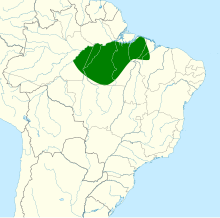Not to be confused with Pesquet's parrot (Psittrichas fulgidus) of New Guinea, which is also sometimes called vulturine parrot.
| Vulturine parrot | |
|---|---|
| Conservation status | |
 Least Concern (IUCN 3.1) | |
| CITES Appendix II (CITES) | |
| Scientific classification | |
| Domain: | Eukaryota |
| Kingdom: | Animalia |
| Phylum: | Chordata |
| Class: | Aves |
| Order: | Psittaciformes |
| Family: | Psittacidae |
| Genus: | Pyrilia |
| Species: | P. vulturina |
| Binomial name | |
| Pyrilia vulturina (Kuhl, 1820) | |

| |
| Synonyms | |
|
Pionopsitta vulturina (Kuhl, 1820) | |
The vulturine parrot (Pyrilia vulturina) is a species of bird in subfamily Arinae of the family Psittacidae, the African and New World parrots. It is endemic to Brazil.
Taxonomy and systematics
Until about 1970 the vulturine parrot had been treated as the only member of genus Gypopsitta before being moved into Pionositta with the pileated parrot (P. pileata) and six other parrots species. All but the pileated parrot were moved into genus Pyrilia in the early 21st century.
In 2002, what had been thought to be the immature plumage of the vulturine parrot was determined to be a separate species, the bald parrot (Pyrilia aurantiocephala).
The vulturine parrot is monotypic.
Description
The vulturine parrot is 23 to 25 cm (9.1 to 9.8 in) long and weighs 138 to 165 g (4.9 to 5.8 oz). The adult's face is mostly bare black skin, with yellowish lores and a collar of yellow feathers and a band of black feathers below that. Their upperparts are green with a reddish orange shoulder. Their breast is olive-yellow, their belly green with some blue edges to the feathers, and their lower thighs yellow. Their primaries are black with green edges and their carpal's edges and underwing coverts are red. Their tail's upper surface is green with blue tips and the lower surface green and yellow. Immature birds have green feathered heads with yellowish around the lores and eye and without the adult's yellow collar.
Distribution and habitat
The vulturine parrot is found in Brazil south of the Amazon River from the Madeira River east to near the Atlantic coast in Maranhão. It inhabits both fairly dry terra firme and seasonally flooded várzea forests.
Behavior
Movement
The vulturine parrot's movements, if any, are not known.
Feeding
Little is known about the vulturine parrot's foraging behavior or diet, but it is suspected that the bare head is an adaptation to avoid feather-matting from large sticky fruits.
Breeding
Nothing is known about the vulturine parrot's breeding biology.
|
Songs and calls Listen to vulturine parrot on xeno-canto |
Vocalization
The vulturine parrot's flight call is "a slightly nasal rhythmic “tree ... trayaweet” or simply “trayaweet”." It makes "a wide variety of calls, ranging from nasal yelps or barks to more melodious whistles and whining sounds, as well as more typically parrot-like calls" when perched.
Status
The IUCN originally assessed the vulturine parrot as Near Threatened, then in 2004 as being of Least Concern, in 2012 as Vulnerable, and since 2021 again as of Least Concern. It has a large range, but its population size is not known and is believed to be decreasing. "The primary threat to this species is accelerating deforestation in the Amazon basin as land is cleared for cattle ranching and soy production, facilitated by expansion of the road network." It is considered uncommon throughout its range. The only protected area within that range is in the western part of it.
References
- ^ BirdLife International (2022). "Pyrilia vulturina". IUCN Red List of Threatened Species. 2022: e.T22686145A209884357. Retrieved 24 February 2023.
- "Appendices | CITES". cites.org. Retrieved February 24, 2023.
- ^ Gill, F.; Donsker, D.; Rasmussen, P., eds. (January 2023). "Parrots, cockatoos". IOC World Bird List. v 13.1. Retrieved 18 February 2023.
- Remsen, J. V., Jr., J. I. Areta, E. Bonaccorso, S. Claramunt, A. Jaramillo, D. F. Lane, J. F. Pacheco, M. B. Robbins, F. G. Stiles, and K. J. Zimmer. 30 January 2023. Species Lists of Birds for South American Countries and Territories. https://www.museum.lsu.edu/~Remsen/SACCCountryLists.htm retrieved January 30, 2023
- ^ Remsen, J. V., Jr., J. I. Areta, E. Bonaccorso, S. Claramunt, A. Jaramillo, D. F. Lane, J. F. Pacheco, M. B. Robbins, F. G. Stiles, and K. J. Zimmer. Version 30 January 2023. A classification of the bird species of South America. American Ornithological Society. https://www.museum.lsu.edu/~Remsen/SACCBaseline.htm retrieved January 30, 2023
- Ribas, C., R. Gaban-Lima, C. Miyaki, and J. Cracraft (2005). Historical biogeography and diversification within the Neotropical parrot genus Pionopsitta (Aves: Psittacidae). Journal Biogeography 32:1409-1427
- Tavares, E.S., Baker, A.J., Pereira, S.L. and Miyaki, C.Y. (2006). Phylogenetic relationships and historical biogeography of Neotropical parrots (Psittaciformes: Psittacidae: Arini) inferred from mitochondrial and nuclear DNA sequences. Syst. Biol. 55(3): 454–470
- Gaban-Lima, R., M. Raposo, and E. Höfling (2002). Description of a New Species of Pionopsitta (Aves: Psittacidae) Endemic to Brazil. Auk 119(3): 815–819
- ^ Collar, N. and P. F. D. Boesman (2020). Vulturine Parrot (Pyrilia vulturina), version 1.0. In Birds of the World (J. del Hoyo, A. Elliott, J. Sargatal, D. A. Christie, and E. de Juana, Editors). Cornell Lab of Ornithology, Ithaca, NY, USA. https://doi.org/10.2173/bow.vulpar1.01 retrieved February 24, 2023
- van Perlo, Ber (2009). A Field Guide to the Birds of Brazil. New York: Oxford University Press. p. 136. ISBN 978-0-19-530155-7.
Further reading
- Juniper, T., and M. Parr (1998). A Guide to the Parrots of the World. Pica Press, East Sussex. ISBN 1-873403-40-2.
